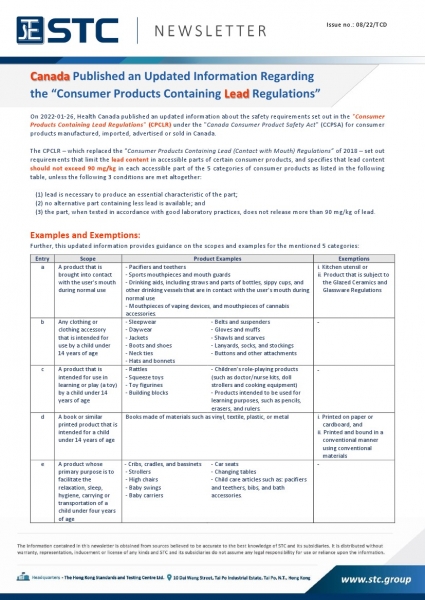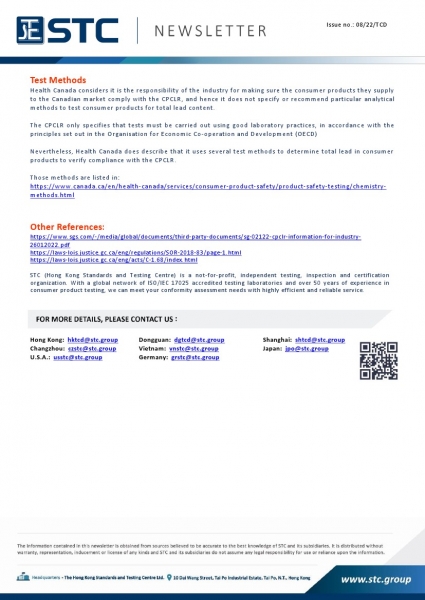
Canada Published an Updated Information Regarding the “Consumer Products Containing Lead Regulations”
On 2022-01-26, Health Canada published an updated information about the safety requirements set out in the "Consumer Products Containing Lead Regulations" (CPCLR) under the "Canada Consumer Product Safety Act" (CCPSA) for consumer products manufactured, imported, advertised or sold in Canada.
The CPCLR – which replaced the "Consumer Products Containing Lead (Contact with Mouth) Regulations" of 2018 – set out requirements that limit the lead content in accessible parts of certain consumer products, and specifies that lead content should not exceed 90 mg/kg in each accessible part of the 5 categories of consumer products as listed in the following table, unless the following 3 conditions are met altogether:
(1) lead is necessary to produce an essential characteristic of the part;
(2) no alternative part containing less lead is available; and
(3) the part, when tested in accordance with good laboratory practices, does not release more than 90 mg/kg of lead.
Examples and Exemptions:
Further, this updated information provides guidance on the scopes and examples for the mentioned 5 categories:
|
Entry |
Scope |
Product Examples |
Exemptions |
|
|
a |
A product that is brought into contact with the user’s mouth during normal use |
- Pacifiers and teethers - Sports mouthpieces and mouth guards - Drinking aids, including straws and parts of bottles, sippy cups, and other drinking vessels that are in contact with the user’s mouth during normal use - Mouthpieces of vaping devices, and mouthpieces of cannabis accessories. |
i. Kitchen utensil or ii. Product that is subject to the Glazed Ceramics and Glassware Regulations |
|
|
b |
Any clothing or clothing accessory that is intended for use by a child under 14 years of age |
- Sleepwear - Daywear - Jackets - Boots and shoes - Neck ties |
- Hats and bonnets - Belts and suspenders - Gloves and muffs - Shawls and scarves - Lanyards, socks, and stockings - Buttons and other attachments |
- |
|
c |
A product that is intended for use in learning or play (a toy) by a child under 14 years of age |
- Rattles - Squeeze toys - Toy figurines - Building blocks |
- Children’s role-playing products (such as doctor/nurse kits, doll strollers and cooking equipment) - Products intended to be used for learning purposes, such as pencils, erasers, and rulers. |
- |
|
d |
A book or similar printed product that is intended for a child under 14 years of age |
Books made of materials such as vinyl, textile, plastic, or metal |
i. Printed on paper or cardboard, and ii. Printed and bound in a conventional manner using conventional materials |
|
|
e |
A product whose primary purpose is to facilitate the relaxation, sleep, hygiene, carrying or transportation of a child under four years of age |
- Cribs, cradles, and bassinets - Strollers - High chairs - Baby swings |
- Baby carriers - Car seats - Changing tables - Child care articles such as: pacifiers and teethers, bibs, and bath accessories. |
- |
Test Methods
Health Canada considers it is the responsibility of the industry for making sure the consumer products they supply to the Canadian market comply with the CPCLR, and hence it does not specify or recommend particular analytical methods to test consumer products for total lead content.
The CPCLR only specifies that tests must be carried out using good laboratory practices, in accordance with the principles set out in the Organisation for Economic Co-operation and Development (OECD).
Nevertheless, Health Canada does describe that it uses several test methods to determine total lead in consumer products to verify compliance with the CPCLR.
Those methods are listed in:
Other References:
https://laws-lois.justice.gc.ca/eng/regulations/SOR-2018-83/page-1.html
https://laws-lois.justice.gc.ca/eng/acts/C-1.68/index.html
Contact us for details.











